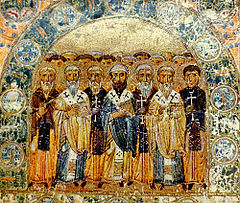
Back Gran iglesia Spanish Grande Église French Gereja Raya ID Fiangonana Lehibe Malagasy Grande Igreja Portuguese Велика црква Serbian Велика церква Ukrainian

The term "Great Church" (Latin: ecclesia magna) is used in the historiography of early Christianity to mean the period of about 180 to 313, between that of primitive Christianity and that of the legalization of the Christian religion in the Roman Empire, corresponding closely to what is called the Ante-Nicene Period. "It has rightly been called the period of the Great Church, in view of its numerical growth, its constitutional development and its intense theological activity."[1]
The Great Church, also called the catholic (i.e., universal) Church,[2] has been defined also as meaning "the Church as defended by such as Ignatius of Antioch, Irenaeus of Lyons, Cyprian of Carthage, and Origen of Alexandria and characterized as possessing a single teaching and communion over and against the division of the sects, e.g., gnosticism, and the heresies".[3]
By the beginning of the fourth century, the Great Church already formed about 15% of the population of the Roman Empire and was ready, both numerically and structurally, for its role as the church of the empire, becoming the state religion of the Roman Empire in 380.[4]
Roger F. Olson says: "According to the Roman Catholic account of the history of Christian theology, the Great Church catholic and orthodox lived on from the apostles to today in the West and all bishops that remained in fellowship with the bishop of Rome have constituted its hierarchy";[5] or, as the Catholic Church itself has expressed it, "This Church constituted and organized in the world as a society, subsists in the Catholic Church, which is governed by the successor of Peter and by the Bishops in communion with him, although many elements of sanctification and of truth are found outside of its visible structure."[6] Thus, the Roman Catholic Church identifies itself as the continuation of the Great Church, which in turn was the same as the early Church founded by Jesus Christ. Because of this, it identifies itself as the "one true church".
The unbroken continuity of the Great Church is affirmed also by the Eastern Orthodox Church: "Orthodoxy regards the Great Church in antiquity (for most of the first millennium) as comprising, on one side, the Eastern Orthodox world (the Byzantine patriarchates presided over by the hierarch of the Church of Constantinople together with the Slavic Orthodox churches); and, on the other side, the Western Catholic Church, presided over by the hierarch of the Church of Rome."[7]
- ^ Karl Rahner. Encyclopedia of Theology: A Concise Sacramentum Mundi. A&C Black; 1 January 1975. ISBN 978-0-86012-006-3. Early Church. pp. 375–376.
- ^ Robert W. Allison, "Early Christianity: Diversity, Conflict, Self-Definition and Dominance" (The Wabash Center)
- ^ The A to Z of the Orthodox Church. Rowman & Littlefield; 2010. ISBN 978-0-8108-7602-6. p. 143.
- ^ Pahner p. 378
- ^ Roger E. Olson. The Story of Christian Theology: Twenty Centuries of Tradition Reform. InterVarsity Press; 1 April 1999. ISBN 978-0-8308-1505-0. p. 278.
- ^ Lumen gentium, 8
- ^ John Anthony McGuckin. The Eastern Orthodox Church: A New History. Yale University Press; 17 March 2020. ISBN 978-0-300-25217-0. p. 7.
© MMXXIII Rich X Search. We shall prevail. All rights reserved. Rich X Search